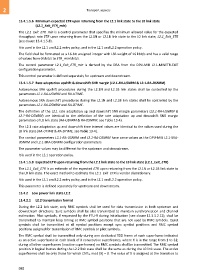Page 998 - 5G Basics - Core Network Aspects
P. 998
2 Transport aspects
13.4.1.5.6 Minimum expected ETR upon returning from the L2.1 link state to the L0 link state
(L2.1_Exit_ETR_min)
The L2.1_Exit_ETR_min is a control parameter that specifies the minimum allowed value for the expected
throughput rate ETR upon returning from the L2.1N or L2.1B link state to the L0 link state, L2.1_Exit_ETR
(see clause 13.4.1.5.8).
It is used in the L2.1 and L2.2 entry policy, and in the L2.1 and L2.2 operation policy.
The field shall be formatted as a 16-bit unsigned integer with LSB weight of 16 kbit/s and has a valid range
of values from 0 kbit/s to ETR_min kbit/s.
The control parameter L2.1_Exit_ETR_min is derived by the DRA from the DPU-MIB L2.1-MINETR-EXIT
configuration parameter.
This control parameter is defined separately for upstream and downstream.
13.4.1.5.7 Rate adaptation upshift & downshift SNR margin (L2.1-RA-USNRM & L2.1-RA-DSNRM)
Autonomous SRA upshift procedures during the L2.1N and L2.1B link states shall be controlled by the
parameters L2.1-RA-USNRM and RA-UTIME.
Autonomous SRA downshift procedures during the L2.1N and L2.1B link states shall be controlled by the
parameters L2.1-RA-DSNRM and RA-DTIME.
The definition of the L2.1 rate adaptation up and downshift SNR margin parameters (L2.1-RA-USNRM &
L2.1-RA-DSNRM) are identical to the definition of the rate adaptation up and downshift SNR margin
parameters of L0 link state (RA-USNRM & RA-DSNRM, see Table 13-4).
The L2.1 rate adaptation up and downshift time interval values are identical to the values used during the
L0 link state (RA-UTIME & RA-DTIME, see Table 13-4).
The control parameters L2.1-RA-USNRM and L2.1-RA-DSNRM have same values as the DPU-MIB L2.1-SRA-
USNRM and L2.1-SRA-DSNRM configuration parameters.
The parameter values may be different for the upstream and downstream.
It is used in the L2.1 operation policy.
13.4.1.5.8 Expected ETR upon returning from the L2.1 link state to the L0 link state (L2.1_Exit_ETR)
The L2.1_Exit_ETR is an estimate of the expected ETR upon returning from the L2.1N or L2.1B link state to
the L0 link state. The exact method to estimate the L2.1_Exit_ETR is vendor discretionary.
It is used in the L2.1 and L2.2 entry policy, and in the L2.1 and L2.2 operation policy.
This parameter is defined separately for upstream and downstream.
13.4.2 Low power link state L2.2
13.4.2.1 L2.2 transmission format
During the L2.2 link state, only RMC symbols shall be used for data transmission in both upstream and
downstream directions. Sync symbols shall be also transmitted to maintain synchronization and channel
estimation. Pilot symbols, if requested by the FTU-R during initialization (see clause 12.3.3.2.12), shall be
transmitted to maintain loop timing at RMC symbol positions that are not used by RMC symbols. Quiet
symbols shall be transmitted at all symbol positions except sync symbol positions and RMC symbol
positions assigned for transmission of RMC symbols or pilot symbols.
The RMC symbol shall be transmitted only during one dedicated TDD frame of each superframe indicated
as an active superframe in each block of X consecutive superframes, where X is in the range from 1 to 32;
during all other superframes (inactive superframes) no RMC symbols shall be transmitted. The RMC symbol
position in logical frames during the L2.2 link state shall be the same as during the L0 link state. The active
superframes shall be only those for which CNTSF mod (X) = 0. The value of X is assigned at the transition to
988

